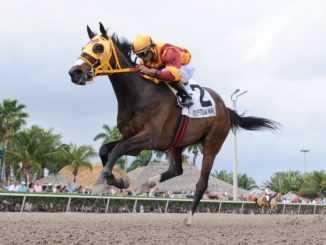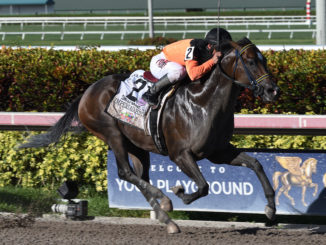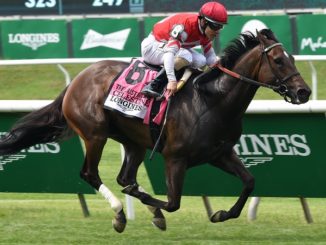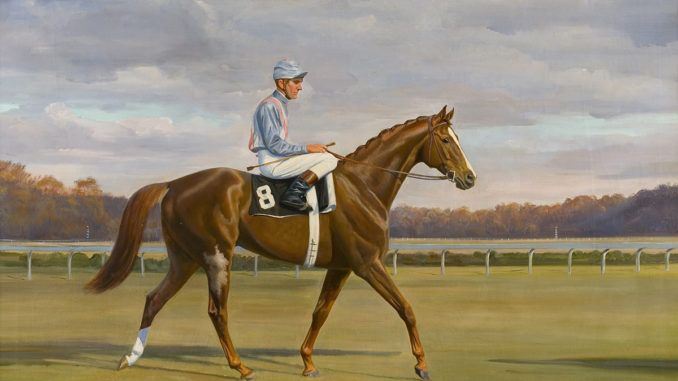
A recent stopover at James Madison’s Montpelier estate in Orange County, Virginia, which provides a vista comparable in beauty to Thomas Jefferson’s Monticello while blissfully attracting a fraction of the latter’s crowds, combined two interests that have sustained me for more than three decades: presidential history and Thoroughbred racing.

My only prior visit to the Montpelier grounds was in 1985, when roadside signage outside the estate indicated that the opening of the mansion to the public was still two years away. Only the Madison family graveyard was accessible to visitors then.
Unbeknownst at the time to an incoming third-grader, Montpelier had only just been released from private hands. Upon the death of Marion duPont Scott in 1983, Montpelier was bequeathed to the National Trust for Historic Preservation, which in the intervening decades has modified the historic home to its original design when occupied by the fourth president and his wife Dolley.
Also unknown was Montpelier’s connection, via Mrs. Scott, to the Thoroughbred world. Given my acquaintance with the sport began within a year of that brief visit, it’s a pleasant thought to attribute that welcome development to serendipity.
Other than family members to whom I briefed ahead of time, I was surely the only member of our small tour group with knowledge of (and an interest in) Montpelier’s role in Thoroughbred history in addition to Madison. At the conclusion of the mansion tour, our excellent, animated guide kindly provided me directions to the small Montpelier Stud Horse Cemetery.

Three horses are memorialized with markers at Montpelier. The most famous of these is Battleship, who in 1938 provided Mrs. Scott with a victory in the Grand National Steeplechase at Aintree. The 1969 Hall of Fame inductee remains the only horse to win both that race and its American equivalent, and is the most recent non-gelded male to land the prize. Battleship later sired champion steeplechasers War Battle and Shipboard.
Alongside Battleship is Annapolis, another son of Man o’ War. Although less prolific as a racer, Annapolis himself sired four steeplechase champions: Rouge Dragon, Mercator, The Mast, and the Montpelier Stable-owned Benguala.
Completing the triumvirate is Accra, a daughter of Annapolis whose place in American steeplechase lore is secure thanks to her son Neji, the first undisputed three-time champion jumper in U.S. history. Accra also provided Mrs. Scott with her finest performer on the flat: Mongo.
A foal of 1959, Mongo was sired by *Royal Charger, a three-quarter brother to the famed *Nasrullah whose signature victory came in the one-mile Queen Anne Stakes at Royal Ascot. He sired six champions in England and Ireland including *Royal Serenade, who made unfathomable advancement from a multiple champion sprinter in England to winner of the prestigious Hollywood Gold Cup over 1 1/4 miles.
Purchased for $300,000 by an American syndicate headed by Spendthrift Farm’s Leslie Combs II, *Royal Charger became an immediate hit in the U.S. when one of his imported sons, *Turn-to, captured the 1953 Garden State Stakes and 1954 Flamingo Stakes and later sired such standouts as Hail to Reason, First Landing, and Sir Gaylord. One of the first stallions to stand for an advertised fee of $10,000, *Royal Charger by the end of the 1950s had sired dual champion fillies Idun and Royal Native, as well as Preakness Stakes winner Royal Orbit.
At the time of *Royal Charger’s death on November 29, 1961, Mongo had won twice in eight tries for Mrs. Scott and trainer Frank “Downey” Bonsal. Not debuting at three until April 6 and thus never a serious contender for the Triple Crown events, by the end of the year he would inspire noted turf writer Charles Hatton to remark that “…few if indeed any of the season’s 3-year-olds was a better racehorse.”

After two wins and second to start 1962, Mongo was finally allowed, in his 12th start, to try two turns. He could not have had a better debut in that regard as he pummeled Futurity Stakes winner Cyane, a son of *Turn-to, by eight lengths in a one-mile allowance at Delaware Park. A follow-up victory in the Lexington Handicap over Aqueduct’s one-turn mile followed.
With his pedigree, it’s no surprise Mongo took to turf like a duck to water. A reputation as one of the finest grass performers of his era was first forged when he captured his infield debut, the Ventnor Turf Handicap at Atlantic City, by 10 lengths. One month later, he captured the United Nations Handicap by a neck over reigning turf champion T. V. Lark.
Only seven three-year-olds have ever won the United Nations, and all but Mongo were voted champion turf horse at season’s end. Not that Mongo wasn’t worthy, but Daily Racing Form didn’t bother naming a grass champion at all in their 1962 year-end poll, an unfortunate decision made three times in the first half of the 1960s.
Besides the United Nations, Mongo’s three-year-old highlight reel also included a photo-finish score over Carry Back in the 1 1/4-mile Trenton Handicap at Garden State Park. Though in receipt of nine pounds from the older champion, Mongo fought back to re-take the lead from Carry Back in the final strides after relinquishing control inside the eighth pole.
Though he won three stakes on dirt in 1963, Mongo continued to show his best on grass. In addition to a course-record victory in the Kelly-Olympic Handicap at Atlantic City over future turf champion Parka, Mongo repeated in the United Nations by two lengths over champions Never Bend and Carry Back, and ended the season with a wire-to-wire victory in the Washington D.C. International by a half-length over the legendary Kelso, whom Hatton noted was “at his throatlatch the last five furlongs.”
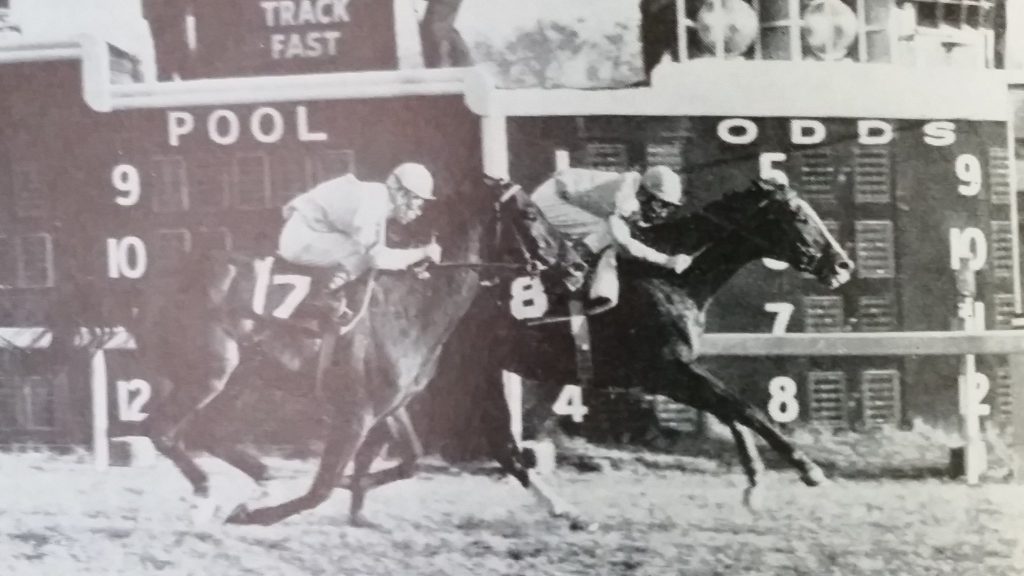
“A half-mile of Kelso is calculated to get a horse fit or possibly put him in traction,” Hatton would reflect later. A turf championship was finally bestowed on Mongo shortly thereafter.
One of the great ironies of Mongo’s career is that his head-to-head success against his Hall of Fame contemporaries never aided him in earning his own enshrinement. Despite finishing second to Carry Back in a Trenton rematch in 1963, it was Mongo’s only loss to him in three meetings. Against five-time Horse of the Year Kelso, Mongo also won two of three. Their last showdown resulted in a neck decision for Mongo in the 1964 Monmouth Handicap over 1 1/4 miles on the dirt.
Third in that Monmouth Handicap was Gun Bow, Kelso’s main challenger for 1964 Horse of the Year honors. Inducted into the Hall of Fame primarily off that one extraordinary season, Gun Bow nonetheless finished behind Mongo in three of their four meetings, with Mongo earning outright victories in the Monmouth and John B. Campbell handicaps.

In another bit of irony given his prowess on turf, all of Mongo’s success at age five came on the main track. In addition to the Campbell and Monmouth, Mongo won the prestigious Widener Handicap at Hialeah and repeated in both the Diamond State Handicap at Delaware and the Trenton at Garden State in a track record 2:00, his final career start after he failed to receive an invitation to defend his International title. Unfortunately, he also went unplaced five times, including inexplicable performances in the United Nations and Boardwalk handicaps over an Atlantic City turf he had previously dominated.
Mongo’s career statistics were 44-22-10-4, $820,766 (approximately $6.7 million in current dollars). His stakes record was 33-16-6-3, while his turf mark was 8-5-1-0.
Mongo resided at Blue Ridge Farm in northern Virginia until his death at age 24 in 1983. He made only a modest impact at stud, siring just two Grade 1 winners: Bushongo (1974 Flamingo) and Mongo Queen (1978 Sorority).
Mrs. Scott later campaigned 1972 champion steeplechaser Soothsayer and 1976 champion older mare Proud Delta, and today her former estate still plays host to the Montpelier Races held over the beautiful yet undulating steeplechase course visible in part from the mansion’s porch. For those willing to follow the action of Breeders’ Cup Saturday at Churchill Downs via mobile device while taking in the fresh autumn air, the Montpelier Races will be held on November 3.
(Photos by Vance Hanson unless otherwise noted)

